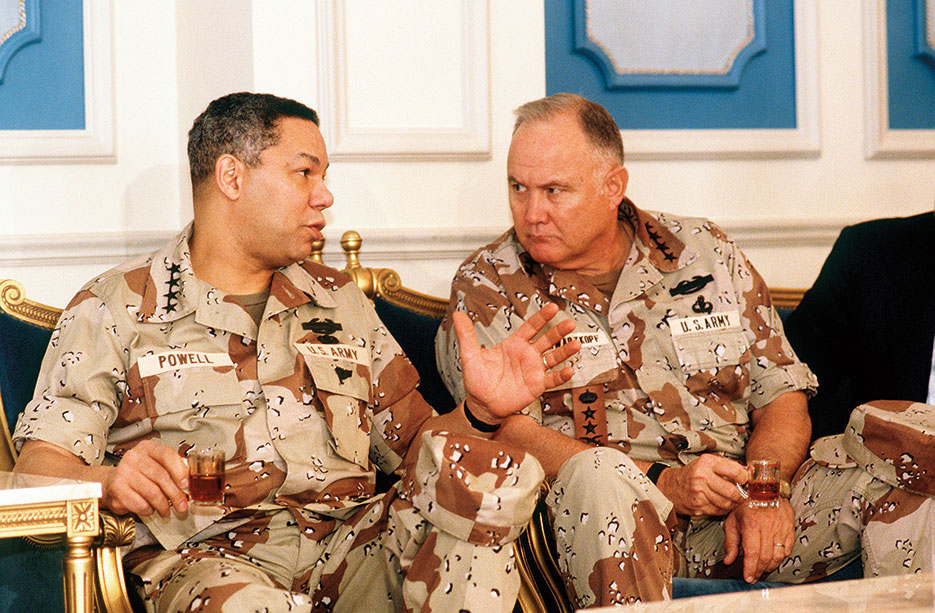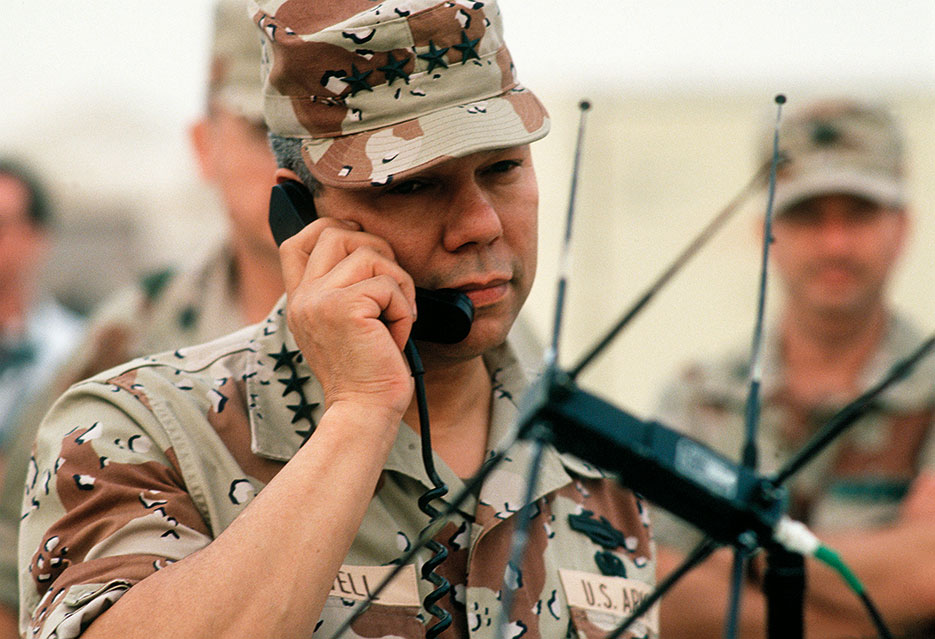William T. Eliason
Executive Summary
23 èþëÿ 2017

April 1, 2017 — General Norman H. Schwarzkopf, Commander, U.S. Central Command, consults with Chairman of the Joint Chiefs of Staff General Colin Powell regarding allied military coalition during Operation Desert Shield, July 18, 1990 (DOD/H.H. Deffner)
The old saying that history is written by the victors does not hold in all cases, but it still has a certain truth to it. Being able to know, with any certainty, what happened in the past is always a challenge, especially for the warrior scholars among us. As Editor in Chief, I have relied on the oral histories of those who have been involved over the years in producing JFQ. As you might expect, we have been fortunate to have many talented people at NDU Press with a common purpose of making General Colin Powell’s vision for the journal a reality.
In a world filled with tweets, Facebook posts, and e-mail, receiving a handwritten letter has become a rare event. Even rarer for me would be to receive a letter from someone who was at the beginning of JFQ’s history. Colonel Frederick “Fred” J. Kiley, USAF, Ph.D., was in my seat at the formation of the journal and worked with General Powell directly to launch it, primarily as a means of fostering jointness among the Services. While I knew this fact, I had never had contact with Fred until he wrote me to discuss the most recent JFQ he had read. After reading his letter, I can say that having one of the founding folks speak so well of the current effort was a great moment in my professional career.
Fred Kiley took General Powell’s vision, found talented people who could make it happen, and then led them to a successful start some 85 issues (plus special editions) ago in 1993. Not bad for someone who was also responsible for hundreds if not thousands of Air Force Academy cadets learning how to write well. (Fred holds a Ph.D. in English and served for over four decades “up on the Terrazzo.”) In a follow-up phone call between us, he helped fill in many of the gaps in my understanding of how and why JFQ came to be. Most important was how he identified his leadership style in just a few minutes of conversation by immediately giving credit to the team he built. Fred began with Robert A. Silano, longtime managing editor, who took Powell’s vision and drove it to execution with great success; he also credited Hans Binnendijk, then in his first tour as director of the Institute for National Strategic Studies here at the National Defense University, for “top cover” in keeping the resources in place in order to make the journal happen. Fred also credited the skills of his staff, including two editors who were here when I arrived in 2010, Calvin Kelley and Martin “Jimmy” Peters, Jr. Just like the joint team they supported, JFQ has remained a unique and successful team effort. In talking about validation of effort from someone who should know what “right” looks like, you could not ask for better.
We continue in the path set down nearly 25 years ago by General Powell, Colonel Kiley, and his NDU-based JFQ team, and we look forward to giving joint issues “a thorough airing” for many years to come.
Our Forum section includes my interview with U.S. Air Force Chief of Staff, General David L. Goldfein. With a bit of pride, the general and I were squadron commanders together at the 31stFighter Wing, Aviano Air Base, Italy, during the air war over Kosovo. I think you will be hard-pressed to find many senior officers who really understand the complexities of today’s joint operations in the way he does. Also, I think you can get a pretty good sense of how he is wrestling with a range of factors that must be addressed as he seeks to implement his vision for the Air Force as a part of the joint force. In a groundbreaking article, Bradley DeWees, Terry C. Pierce, Ervin J. Rokke, and Anthony Tingle describe how best to understand the results of kinetic and nonkinetic actions (think bullets and bombs versus cyber attacks) across all the domains that the joint force operates in and then use that understanding to improve the use of the force. The key lies in how we understand how war is fought in the 21st century. In another view of part of that key terrain, William R. Gery, SeYoung Lee, and Jacob Ninas add to our understanding of modern information warfare. In addition, the rapid expansion globally of drones or small unmanned aircraft systems available from commercial sources has driven Anthony Tingle and David Tyree to think about what kind of threat they might pose.

Chairman of the Joint Chiefs of Staff General Colin Powell speaks via satellite to Pentagon while visiting troops during Operation Desert Shield (DOD/Jeff Wright)
Commentary has two think pieces that invite us to consider saving a valuable but rapidly diminishing capability in one case and the need to add capability in the other. The ability to use forensics to assess the vulnerabilities of our opponents might seem like an obvious requirement, and Darryl Williams argues this capability is fast becoming a lost art. Erick D. McCroskey and Charles A. Mock have developed an important, and so far, unachieved capability—how to graphically depict cyberspace operations.
In Features, we cover a range of issues associated with the dynamic security environment of the 21stcentury. George K. Dixon describes the requirement for a Joint Support Element as a part of our noncombatant evacuation operations, which seem to be happening with greater frequency. As local policing methods have become more militarized in recent years, Steven C. Dowell, Jr., takes a fresh look at the merging of military capabilities in law enforcement and the potential implications for the Posse Comitatus Act. As many readers will be familiar with our continuing discussion on health security, a frequent contributor to JFQ from the Joint Staff, George E. Katsos, discusses the U.S. Government’s focus on medical operations in joint campaigns.
Recall returns us to the first Gulf War, as Christopher G. Marquis, Denton Dye, and Ross S. Kinkead provide a historical review of the evolution of jointness since the victory won in Operation Desert Storm in 1991. In the Joint Doctrine section, we have two important articles with insights from our recent conflicts. Nicholas J. Petren takes us to the attacks in 2012 on Camp Bastion-Leatherneck-Shorabak in Afghanistan, where he suggests improvements in how the joint force provides security for our forward deployed bases. Kevin D. Smith, Mark H. Lauber, and Matthew B. Robbins next give us a rundown on the updated Joint Publication 3-20, Security Cooperation. You will also find the Joint Doctrine Update and three valuable book reviews.
What do you see happening in the joint force today? Are we a better fighting force 30 years after Goldwater-Nichols? What do you see as the important issues today and going forward? Our JFQaudience wants to hear what you have to say. You have made JFQ “one of the most thoroughly read and influential journals” in the military profession, as General Powell had wanted. Only you can continue to let leadership know what you are thinking. JFQ is here to help you do just that. JFQ
William T. Eliason
Editor in Chief
Âåðíóòüñÿ íàçàä